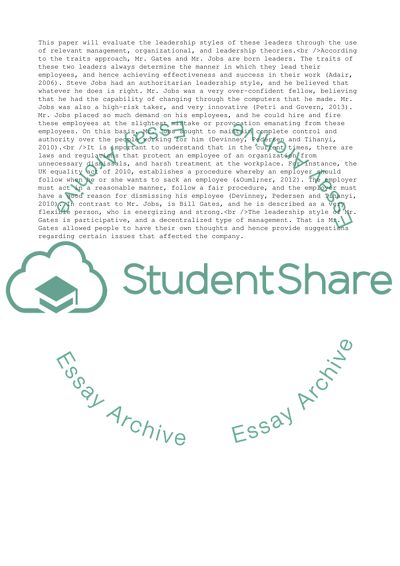Cite this document
(The Leadership Styles of Gates and Jobs Essay Example | Topics and Well Written Essays - 1500 words - 1, n.d.)
The Leadership Styles of Gates and Jobs Essay Example | Topics and Well Written Essays - 1500 words - 1. https://studentshare.org/management/1815312-using-relevant-leadership-management-and-organisational-theory-covered-in-the-slides-provided-compare-and-contrast-and-critically-discuss-the-leadership-styles-of-bill-gates-and-steve-jobs-consider-the-impact-their-respective-styles-and-behaviour-had
The Leadership Styles of Gates and Jobs Essay Example | Topics and Well Written Essays - 1500 words - 1. https://studentshare.org/management/1815312-using-relevant-leadership-management-and-organisational-theory-covered-in-the-slides-provided-compare-and-contrast-and-critically-discuss-the-leadership-styles-of-bill-gates-and-steve-jobs-consider-the-impact-their-respective-styles-and-behaviour-had
(The Leadership Styles of Gates and Jobs Essay Example | Topics and Well Written Essays - 1500 Words - 1)
The Leadership Styles of Gates and Jobs Essay Example | Topics and Well Written Essays - 1500 Words - 1. https://studentshare.org/management/1815312-using-relevant-leadership-management-and-organisational-theory-covered-in-the-slides-provided-compare-and-contrast-and-critically-discuss-the-leadership-styles-of-bill-gates-and-steve-jobs-consider-the-impact-their-respective-styles-and-behaviour-had.
The Leadership Styles of Gates and Jobs Essay Example | Topics and Well Written Essays - 1500 Words - 1. https://studentshare.org/management/1815312-using-relevant-leadership-management-and-organisational-theory-covered-in-the-slides-provided-compare-and-contrast-and-critically-discuss-the-leadership-styles-of-bill-gates-and-steve-jobs-consider-the-impact-their-respective-styles-and-behaviour-had.
“The Leadership Styles of Gates and Jobs Essay Example | Topics and Well Written Essays - 1500 Words - 1”. https://studentshare.org/management/1815312-using-relevant-leadership-management-and-organisational-theory-covered-in-the-slides-provided-compare-and-contrast-and-critically-discuss-the-leadership-styles-of-bill-gates-and-steve-jobs-consider-the-impact-their-respective-styles-and-behaviour-had.


